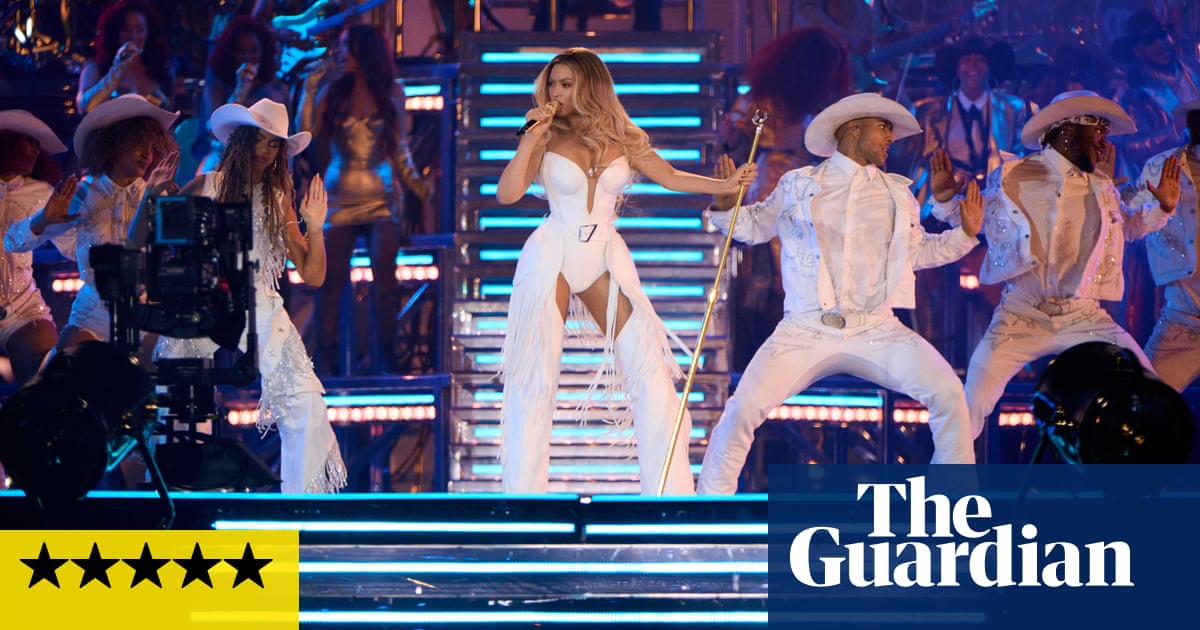Beyoncédoesn’t just take the stage – she takes the narrative back. On opening night of her Cowboy Carter world tour at the four-year-old SoFi Stadium in Inglewood, California, she brings forth a sweeping, theatrical spectacle that reclaims country music, reframes American identity and reminds everyone who’s still driving pop’s evolution after all these years. Her nearly three-hour, seven-act performance draws heavily from Cowboy Carter – her Grammy-winning country epic – and threads in nods to Renaissance, the ballroom-infused predecessor that lit up stadiums barely two years ago. Rather than stake a claim in country, Beyoncé goes deeper: celebrating the Black roots of the genre and exploding its boundaries with precision, power and polish.
Outside SoFi, vendors hawk more cowboy hats than you’d see at a Los Tigres del Norte show. Inside, anticipation sizzles. Projected across the massive stage-length screen: CHITLIN’ CIRCUIT – a nod to the historic Black music venues where blues, country and rock took shape. The show begins with American Requiem – the Sign o’ the Times-drizzled opener from Cowboy Carter – followed by a haunting Blackbiird. Then comes a defining moment: a Hendrix-inspired Star-Spangled Banner, laced with the thunder of Freedom, flashing red, white and blue. The screen reads: “Never ask permission for something that already belongs to you.”
Images of Linda Martell and other Black country pioneers flash behind her asBeyoncé– in a white Mugler leather set and matching cowboy hat – thanks “those who came before me” and praises fans for “giving me the creative liberty to challenge myself”. Ya Ya kicks the tempo up, Blue Ivy joining the dancers as Beyoncé shakes off her cowboy hat and flips her hair like it’s 2003. By the time she reclines on a throne and a robotic arm pours her a whiskey, the crowd is all in.
Act two opens with a sharp-shouldered, Janet Jackson-flecked America Has a Problem, delivered behind a press podium. Then come Spaghettii, Formation and Diva, the last complete with a deadpan TikTok-inspired bit. The band rises on three-story platforms as horns blast and dancers swarm. Blue Ivy returns, nailing the Déjà Vu choreography and earning a roar from the crowd.
Act three softens. Alliigator Tears and Just for Fun give way to Protector. “This is my first time singing these songs,” Beyoncé says. “I’m so happy to be singing them with you.” Her seven-year-old daughter, Rumi, joins her onstage, beaming and waving mid-song. Behind them appears a tribute: “I once had a thousand desires / But in my one desire to know you / all else melted away.” Throughout, Beyoncé’s attention to detail is unmatched. Every movement and frame is measured. Her team – a small city of dancers, designers, stylists and crew – maintains astonishing cohesion. The show is genreless in the best sense: fiddles accompany gospel vocals, a robotic arm shares space with a golden mechanical bull.
Visuals and interludes deepen the themes. Western vignettes cast Beyoncé as an outsider. In one stylized duel, an older white cowboy unloads bullets – they bounce off her body. She is, as ever, bulletproof. Desert Eagle, Riiverdance and II Hands II Heaven follow under warm, glowing lights. During Sweet Honey Buckiin’, Beyoncé and her dancers groove in chaps and belts while Blue Ivy takes center stage again.
The Renaissance era still pulses: she rides a mechanical bull during Tyrant, just as she once rode Reneigh, her disco horse. “Welcome back to the Renaissance, y’all,” she says, as I’m That Girl, Cozy and Alien Superstar unfold with the same crisp choreography and glittering, refashioned props. Then comes Daddy Lessons, performed live for the first time since 2016’s Lemonade tour, as Beyoncé flies across the stadium on a massive pink horseshoe. Cuff It gets a sweaty, slowed-down treatment on a satellite stage. Later, she nods to Destiny’s Child with elements of Bills, Bills, Bills in Thique, images of the group playing onscreen.
As the show stretches toward its final act, the transitions grow looser but no less captivating. A remix of Texas Hold ’Em melts into Crazy in Love and Heated, before Before I Let Go lifts the crowd to a final release. The songs still come fast – 36 in total – but there’s space for moments, too. For 16 Carriages, Beyoncé boards a glowing red convertible and soars above the stadium, leading a massive singalong. She closes with Amen – the bookend that concludes Cowboy Carter – draped in a US flag gown in front of a masked Statue of Liberty head with braided hair: a final image both symbolic and searing.
At 43, Beyoncé isn’t circling the globe like she did for Renaissance – but her 10th concert tour is a theatrical, tightly executed masterwork. She isn’t here to prove she belongs. She’s here to remind us she already owns it. And if this is only Act II, the real takeaway might be just how powerful Act III will be when it finally lands.
